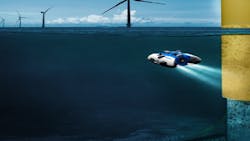Consortium gets grant funding for autonomous offshore wind inspection
Offshore staff
ABERDEEN — An international consortium has been awarded an Enterprise Singapore - Innovate UK grant to develop an autonomous structural integrity inspection capability.
Autonomous robotics specialist BeeX, offshore survey and inspection specialist Sulmara and structural integrity specialists at the University of Strathclyde aim to deliver an autonomous low-carbon solution for wind farm integrity monitoring. The end goal is a Robotics-as-a-Service (RaaS) technology that will drastically reduce the resources required to conduct essential underwater inspections and asset integrity assessment of offshore wind turbines.
This technology will be designed to reduce emissions related to inspection activities in the wind sector. Large diesel fueled and carbon intensive vessels are currently required to inspect energy assets, making the introduction of optimized, automated, lower carbon technologies a crucial part of any net-zero future, the consortium said.
Assisted by the grant funding, BeeX will be delivering its Hovering Autonomous Underwater Vehicle (HAUV) specifically for offshore wind; carrying specific survey and inspection payloads suitable for monopile and jacket inspections, piloted by artificial intelligence to automate inspection tasks and deliver repeatable efficient inspection of wind farm monopiles from seabed to the air water interface.
This HAUV platform's new features will include enhanced endurance and improved sensor payload from critical learnings discovered from BeeX experience with its flagship HAUV, A.IKANBILIS, on the Nordsee One wind farm offshore Germany last year.
Sulmara’s scope will define the vertical asset inspection capabilities and sensor payloads needed for this next-generation HAUV, and the company also will be managing field trials and demonstration of the system alongside BeeX in 2024, with the aim to integrate the HAUV into a bespoke unmanned surface vessel (USV).
The inspection missions will be optimized based on research by the University of Strathclyde, in developing a structural integrity framework to generate risk-based, fit-for-purpose, inspection missions that will feed into the HAUV automated mission control software.
Operations and maintenance costs at offshore wind farms remain the biggest operational cost. The costs are largely driven by the use of large, specialized dynamically positioned (DP2) vessels to deploy work-class ROVs. A HUAV hosted from a USV, both optimized for the offshore wind sector, can build on and improve the capabilities of the current work-class ROVs hosted from larger crewed vessels.
BeeX CEO Grace Chia said, “By 2025, we expect BeeX’s fully autonomous systems to help wind farm developers and operators reduce costs and risks to a fraction of today’s, from consenting to end of life. This grant funding is a critical piece of financing that unlocks the partners’ abilities to enable safer and clean energy for all, and we look forward to deployments at more wind farms across Europe.”
Professor Feargal Brennan, head of Department for Naval Architecture Ocean and Marine Engineering at Strathclyde, added, “The climate emergency demands that we apply the very best innovation to ensure better underwater data collection methodologies. We look forward to delivering this research and to seeing our innovations applied to achieve breakthroughs in remote subsea inspection.”
02.15.2023
